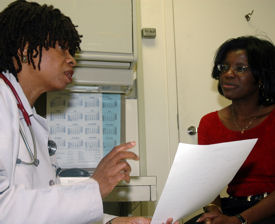Interacting with the computer screen instead of the patient
Computer screen can be barrier between doctor and patient.
PHILADELPHIA—When the Cleveland Clinic implemented electronic health records (EHRs) in 2003, hospital administrators had a pretty good idea of the expected benefits: increased physician efficiency, improved coding and billing accuracy, and reduced the need for transcription services.
However, once the EHRs were installed, some unexpected disadvantages began to appear, Cleveland Clinic division administrator Andrea Kanter Jacobs told attendees at the Medical Group Management Association's annual meeting.
“A complaint that I got a lot from the physicians was that they felt like data-entry clerks,” she said.
To evaluate how much time doctors spent on data entry and to assess the overall impact of the EHRs, administrators began a study of one Cleveland Clinic facility—the Beachwood Family Health and Surgery Center.
An operations analyst followed eight doctors and timed with a stopwatch the activities that filled their days. Not surprisingly, she confirmed that the physicians were spending a lot of time entering data into the computer. However, her study also uncovered the unsuspected effects of the data entry on physician-patient interactions.
“One-third of the time that the doctor was in the exam room, he or she was staring at the computer,” said co-presenter and Beachwood medical director Michael A. Rabovsky, MD. The rates varied by physician—with those most comfortable with computers spending the least time looking at them—but some doctors spent 40% of their time looking at the computer versus 12%-16% interacting with the patient.
The Cleveland Clinic's findings were similar to an Israeli study (published in Patient Education and Counseling in 1996) that found physicians spent 24%-42% of their time gazing at the computer, and that screen gaze time increased visit length but reduced the dialogue between physicians and patients, Dr. Rabovsky said.
“A lot of the heart of medicine—the biopsychosocial stuff—was missing,” he said. “They weren't asking how Grandma is and did Johnny win the soccer game.”
EHRs successfully reminded physicians to ask all the necessary questions about symptoms, to follow up on chronic conditions, and to ensure that patient visits are technically complete. “Those things were done better, but the chatting and actual patient interactions weren't done as well,” said Dr. Rabovsky.
Awareness of the problem may be the first step to fixing it, noted Dr. Rabovsky, who was one of the eight studied doctors. “As soon as I saw the results, I tried to change my own behavior.”
The Cleveland Clinic has also looked at options to reduce the time physicians spend staring at computers. Medical assistants could be trained to go over the health maintenance section of the EHR with patients to save physicians some data entry. Clinic administrators are also considering voice recognition software or hiring transcribers to sit in the room during the visit.
Dr. Rabovsky said it could be awkward to add an extra person to the patient-physician encounter, but added, “The computer already is the third person in the room.”
In the long run, however, the distraction of the computer screen is a problem that physicians and patients will just have to learn to work around, he concluded. “I think it's probably changed [the physician-patient encounter] permanently because everyone's going to electronic medical records.”




